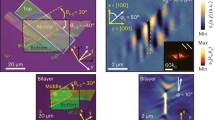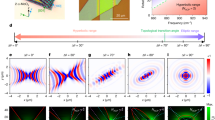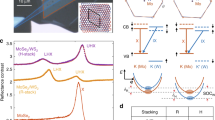Abstract
Moiré engineering is being intensively investigated as a method to tune the electronic, magnetic and optical properties of twisted van der Waals materials. Advances in moiré engineering stem from the formation of peculiar moiré superlattices at small, specific twist angles. Here we report configurable nanoscale light–matter waves—phonon polaritons—by twisting stacked α-phase molybdenum trioxide (α-MoO3) slabs over a broad range of twist angles from 0° to 90°. Our combined experimental and theoretical results reveal a variety of polariton wavefront geometries and topological transitions as a function of the twist angle. In contrast to the origin of the modified electronic band structure in moiré superlattices, the polariton twisting configuration is attributed to the electromagnetic interaction of highly anisotropic hyperbolic polaritons in stacked α-MoO3 slabs. These results indicate twisted α-MoO3 to be a promising platform for nanophotonic devices with tunable functionalities.
This is a preview of subscription content, access via your institution
Access options
Access Nature and 54 other Nature Portfolio journals
Get Nature+, our best-value online-access subscription
$29.99 / 30 days
cancel any time
Subscribe to this journal
Receive 12 print issues and online access
$259.00 per year
only $21.58 per issue
Buy this article
- Purchase on Springer Link
- Instant access to full article PDF
Prices may be subject to local taxes which are calculated during checkout



Similar content being viewed by others
Data availability
All other data that support the findings of this study are available from the corresponding author upon reasonable request. Source data are provided with this paper.
Code availability
The custom code employed in this work to perform all calculations is available from the corresponding author upon reasonable request.
Change history
28 July 2020
An amendment to this paper has been published and can be accessed via a link at the top of the paper.
References
Novoselov, K. S., Mishchenko, A., Carvalho, A. & Castro Neto, A. H. 2D materials and van der Waals heterostructures. Science 353, aac9439 (2016).
Ribeiro-Palau, R. et al. Twistable electronics with dynamically rotatable heterostructures. Science 361, 690–693 (2018).
Ponomarenko, L. A. et al. Cloning of Dirac fermions in graphene superlattices. Nature 497, 594–597 (2013).
Dean, C. R. et al. Hofstadter’s butterfly and the fractal quantum Hall effect in moiré superlattices. Nature 497, 598–602 (2013).
Hunt, B. et al. Massive Dirac fermions and Hofstadter butterfly in a van der Waals heterostructure. Science 340, 1427–1430 (2013).
Cao, Y. et al. Unconventional superconductivity in magic-angle graphene superlattices. Nature 556, 43–50 (2018).
Sharpe, A. L. et al. Emergent ferromagnetism near three-quarters filling in twisted bilayer graphene. Science 365, 605–608 (2019).
Tran, K. et al. Evidence for moiré excitons in van der Waals heterostructures. Nature 567, 71–75 (2019).
Alexeev, E. M. et al. Resonantly hybridized excitons in moiré superlattices in van der Waals heterostructures. Nature 567, 81–86 (2019).
Jin, C. et al. Observation of moiré excitons in WSe2/WS2 heterostructure superlattices. Nature 567, 76–80 (2019).
Seyler, K. L. et al. Signatures of moiré-trapped valley excitons in MoSe2/WSe2 heterobilayers. Nature 567, 66–70 (2019).
Basov, D. N., Fogler, M. M. & García de Abajo, F. J. Polaritons in van der Waals materials. Science 354, aag1992 (2016).
Low, T. et al. Polaritons in layered two-dimensional materials. Nat. Mater. 16, 182–194 (2016).
Ni, G. X. et al. Plasmons in graphene moiré superlattices. Nat. Mater. 14, 1217–1222 (2015).
Sunku, S. S. et al. Photonic crystals for nano-light in moire graphene superlattices. Science 362, 1153–1156 (2018).
Jiang, L. et al. Soliton-dependent plasmon reflection at bilayer graphene domain walls. Nat. Mater. 15, 840–844 (2016).
Hu, F. et al. Real-space imaging of the tailored plasmons in twisted bilayer graphene. Phys. Rev. Lett. 119, 247402 (2017).
Ma, W. et al. In-plane anisotropic and ultra-low-loss polaritons in a natural van der Waals crystal. Nature 562, 557–562 (2018).
Zheng, Z. et al. A mid-infrared biaxial hyperbolic van der Waals crystal. Sci. Adv. 5, eaav8690 (2019).
Dai, S. et al. Tunable phonon polaritons in atomically thin van der Waals crystals of boron nitride. Science 343, 1125–1129 (2014).
Atkin, J. M., Berweger, S., Jones, A. C. & Raschke, M. B. Nano-optical imaging and spectroscopy of order, phases, and domains in complex solids. Adv. Phys. 61, 745–842 (2012).
Dai, S. et al. Efficiency of launching highly confined polaritons by infrared light incident on a hyperbolic material. Nano Lett. 17, 5285–5290 (2017).
Alonso-González, P. et al. Controlling graphene plasmons with resonant metal antennas and spatial conductivity patterns. Science 344, 1369–1373 (2014).
Hu, G., Shen, J., Qiu, C.-W., Alù, A. & Dai, S. Phonon polaritons and hyperbolic response in van der Waals materials. Adv. Opt. Mater. 8, 1901393 (2020).
Caldwell, J. D. et al. Sub-diffractional volume-confined polaritons in the natural hyperbolic material hexagonal boron nitride. Nat. Commun. 5, 5221 (2014).
Gomez-Diaz, J. S., Tymchenko, M. & Alù, A. Hyperbolic plasmons and topological transitions over uniaxial metasurfaces. Phys. Rev. Lett. 114, 233901 (2015).
Krishnamoorthy, H. N., Jacob, Z., Narimanov, E., Kretzschmar, I. & Menon, V. M. Topological transitions in metamaterials. Science 336, 205–209 (2012).
Álvarez-Pérez, G. et al. Infrared permittivity of the biaxial van der Waals semiconductor α-MoO3 from near- and far-field correlative studies. Adv. Mater. https://doi.org/10.1002/adma.201908176 (2020).
Renuka, M. et al. Dispersion engineering of hyperbolic plasmons in bilayer 2D materials. Opt. Lett. 43, 5737–5740 (2018).
Nemilentsau, A., Low, T. & Hanson, G. Anisotropic 2D materials for tunable hyperbolic plasmonics. Phys. Rev. Lett. 116, 066804 (2016).
Hu, G., Krasnok, A., Mazor, Y., Qiu, C.-W. & Alù, A. Moiré hyperbolic metasurfaces. Nano Lett. 20, 3217–3224 (2020).
Chaudhary, K. et al. Engineering phonon polaritons in van der Waals heterostructures to enhance in-plane optical anisotropy. Sci. Adv. 5, eaau7171 (2019).
Fali, A. et al. Refractive index-based control of hyperbolic phonon-polariton propagation. Nano Lett. 19, 7725–7734 (2019).
Brar, V. W. et al. Hybrid surface-phonon-plasmon polariton modes in graphene/monolayer h-BN heterostructures. Nano Lett. 14, 3876–3880 (2014).
Dai, S. et al. Graphene on hexagonal boron nitride as a tunable hyperbolic metamaterial. Nat. Nanotechnol. 10, 682–686 (2015).
Woessner, A. et al. Highly confined low-loss plasmons in graphene–boron nitride heterostructures. Nat. Mater. 14, 421–425 (2015).
Caldwell, J. D. et al. Atomic-scale photonic hybrids for mid-infrared and terahertz nanophotonics. Nat. Nanotechnol. 11, 9–15 (2016).
Jacob, Z. et al. Engineering photonic density of states using metamaterials. Appl. Phys. B 100, 215–218 (2010).
Galfsky, T., Gu, J., Narimanov, E. E. & Menon, V. M. Photonic hypercrystals for control of light-matter interactions. Proc. Natl Acad. Sci. USA 114, 5125–5129 (2017).
Guo, Y., Cortes, C. L., Molesky, S. & Jacob, Z. Broadband super-Planckian thermal emission from hyperbolic metamaterials. Appl. Phys. Lett. 101, 131106 (2012).
Hoang, T. B., Akselrod, G. M. & Mikkelsen, M. H. Ultrafast room-temperature single photon emission from quantum dots coupled to plasmonic nanocavities. Nano Lett. 16, 270–275 (2016).
Bogdanov, S. I. et al. Ultrabright room-temperature sub-nanosecond emission from single nitrogen-vacancy centers coupled to nanopatch antennas. Nano Lett. 18, 4837–4844 (2018).
Rivera, N., Kaminer, I., Zhen, B., Joannopoulos, J. D. & Soljacic, M. Shrinking light to allow forbidden transitions on the atomic scale. Science 353, 263–269 (2016).
Newman, W. D. et al. Observation of long-range dipole–dipole interactions in hyperbolic metamaterials. Sci. Adv. 4, eaar5278 (2018).
Duan, J. et al. Twisted nano-optics: manipulating light at the nanoscale with twisted phonon polaritonic slabs. Nano Lett. https://doi.org/10.1021/acs.nanolett.0c01673 (2020).
Hu, G. et al. Topological polaritons and photonic magic angles in twisted α-MoO3 bilayers. Nature 582, 209–213 (2020).
Zheng, Z. et al. Phonon polaritons in twisted double-layers of hyperbolic van der Waals crystals. Nano Lett. https://doi.org/10.1021/acs.nanolett.0c01627 (2020).
Acknowledgements
We acknowledge helpful discussions with X. Jiang, J. Lin and T. Low. Work at Auburn University was supported by the Auburn University Intramural Grants Program and National Science Foundation under grant no. DMR-2005194. Work in P.J.-H.’s group was supported through AFOSR grant FA9550-16-1-0382 (fabrication), and the Gordon and Betty Moore Foundation’s EPiQS Initiative through grant GBMF4541 to P.J.-H. This work made use of the Materials Research Science and Engineering Center Shared Experimental Facilities supported by the National Science Foundation (NSF) (grant number DMR-0819762). The work at Zhejiang University was sponsored by the National Natural Science Foundation of China (NNSFC) under grant numbers 61625502, 11961141010 and 61975176, the Top-Notch Young Talents Program of China, and the Fundamental Research Funds for the Central Universities.
Author information
Authors and Affiliations
Contributions
M.C. and X.L. contributed equally to this work. S.D. conceived the idea and designed the experiments. M.C. performed the optical experiments. T.D., Z.Z. and Q.M. prepared the samples. X.L. and H.C. developed the theory. M.C. and J.S. performed the simulation. M.C. and S.D. analysed the data. M.C., S.D. and X.L. wrote the manuscript, with input and comments from all authors. S.D., H.C. and P.J.-H. supervised the project.
Corresponding author
Ethics declarations
Competing interests
The authors declare no competing interests.
Additional information
Publisher’s note Springer Nature remains neutral with regard to jurisdictional claims in published maps and institutional affiliations.
Supplementary information
Supplementary Information
Supplementary Figs. 1–10.
Supplementary Video 1
k-space isofrequency curve of twisted α-MoO3 in the range 0°–180°.
Source data
Source Data Fig. 1
Numerical data used to generate Fig. 3g.
Rights and permissions
About this article
Cite this article
Chen, M., Lin, X., Dinh, T.H. et al. Configurable phonon polaritons in twisted α-MoO3. Nat. Mater. 19, 1307–1311 (2020). https://doi.org/10.1038/s41563-020-0732-6
Received:
Accepted:
Published:
Issue Date:
DOI: https://doi.org/10.1038/s41563-020-0732-6
This article is cited by
-
Van der Waals quaternary oxides for tunable low-loss anisotropic polaritonics
Nature Nanotechnology (2024)
-
Strain tuning MoO3 vibrational and electronic properties
npj 2D Materials and Applications (2024)
-
Observation of naturally canalized phonon polaritons in LiV2O5 thin layers
Nature Communications (2024)
-
Tunable anisotropic van der Waals films of 2M-WS2 for plasmon canalization
Nature Communications (2024)
-
Deeply subwavelength mid-infrared phase retardation with α-MoO3 flakes
Communications Materials (2024)



